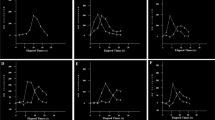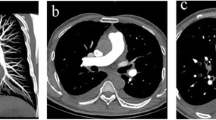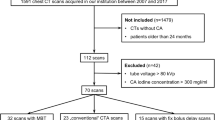Abstract
Object The aim of our study is to determine if the respiratory position (free breathing, end expiration) influences bolus arrival time (BAT) or the quality of the SI-time curve in the test bolus measurement.
Materials and methods We examined 150 consecutive patients in free breathing and end expiration with 1 mL contrast media (CM) and a flow of 3 mL/s with MRI. The BAT in the aorta and the quality of the SI-time curve were determined.
Results In 13/300 measurements BAT could not be determined because of poor quality of the SI-time curve (two free breathing, 11 end expiration). Mean BAT was 21 s in both respiratory positions. In 13/137 (9%) there was a difference in BAT in end expiration and free breathing of more than 5 s without a tendency towards elongation or shortening of BAT due to the respiratory command (RC). Quality of the SI-time curve was significantly better in the second of both measurements independently of the respiratory position and in free breathing compared to end expiration.
Conclusion Test bolus examinations may differ in an individual patient of more than 5 s without a tendency towards elongation or shortening due to the RC. SI-time curve quality is negatively influenced by the RC.
Similar content being viewed by others
References
Bae KT (2003). Peak contrast enhancement in CT and MR angiography: when does it occur and why? Pharmacokinetic study in a porcine model. Radiology 227: 809–816
Bae KT (2005). Comparison of moderate versus high concentration of contrast media injected at the same total iodine dose and fixed injection duration. Radiology 236: 740–741 (author reply 741)
Krause U, Kroencke T, Spielhaupter E, Taupitz M, Kenn W, Hamm B and Hahn D (2005). Contrast-enhanced magnetic resonance angiography of the lower extremities: standard-dose versus high-dose gadodiamide injection. J Magn Reson Imaging 21: 449–454
Lee JJ, Chang Y, Tirman PJ, Ryum HK, Lee SK, Kim YS and Kang DS (2001). Optimizing of gadolinium-enhanced MR angiography by manipulation of acquisition and scan delay times. Eur Radiol 11: 754–766
Boos M, Scheffler K, Haselhorst R, Reese E, Frohlich J and Bongartz GM (2001). Arterial first pass gadolinium-CM dynamics as a function of several intravenous saline flush and Gd volumes. J Magn Reson Imaging 13: 568–576
Fleischmann D (2003). Use of high concentration contrast media: principles and rationale-vascular district. Eur J Radiol 45(Suppl 1): S88–S93
Prince MR, Chabra SG, Watts R, Chen CZ, Winchester PA, Khilnani NM, Trost D, Bush HA, Kent KC and Wang Y (2002). Contrast material travel times in patients undergoing peripheral MR angiography. Radiology 224: 55–61
Watanabe Y, Dohke M, Okumura A, Amoh Y, Ishimori T, Oda K, Hayashi T, Hiyama A and Dodo Y (2000). Dynamic subtraction contrast-enhanced MR angiography: technique, clinical applications, and pitfalls. Radiographics 20: 135–152 (discussion 152–133)
Kanematsu M, Semelka RC, Matsuo M, Kondo H, Enya M, Goshima S, Moriyama N and Hoshi H (2002). Gadolinium-enhanced MR imaging of the liver: optimizing imaging delay for hepatic arterial and portal venous phases—a prospective randomized study in patients with chronic liver damage. Radiology 225: 407–415
Krinsky GA, Kaminer E, Lee VS, Rofsky NM and Weinreb JC (1998). The effects of apnea on timing examinations for optimization of gadolinium-enhanced MRA of the thoracic aorta and arch vessels. J Comput Assist Tomogr 22: 677–681
Shors SM, Cotts WG, Pavlovic-Surjancev B, Francois CJ, Gheorghiade M and Finn JP (2003). Heart failure: evaluation of cardiopulmonary transit times with time-resolved MR angiography. Radiology 229: 743–748
Sakuma H, Kawada N, Kubo H, Nishide Y, Takano K, Kato N and Takeda K (2001). Effect of breath holding on blood flow measurement using fast velocity encoded cine MRI. Magn Reson Med 45: 346–348
Author information
Authors and Affiliations
Corresponding author
Additional information
An erratum to this article can be found at http://dx.doi.org/10.1007/s10334-007-0083-1
Rights and permissions
About this article
Cite this article
Janka, R., Marius, R., Michael, L. et al. Test bolus measurement: effects of the respiratory position on bolus arrival time and signal-intensity-time curve quality. Magn Reson Mater Phy 20, 175–179 (2007). https://doi.org/10.1007/s10334-007-0080-4
Received:
Revised:
Accepted:
Published:
Issue Date:
DOI: https://doi.org/10.1007/s10334-007-0080-4




